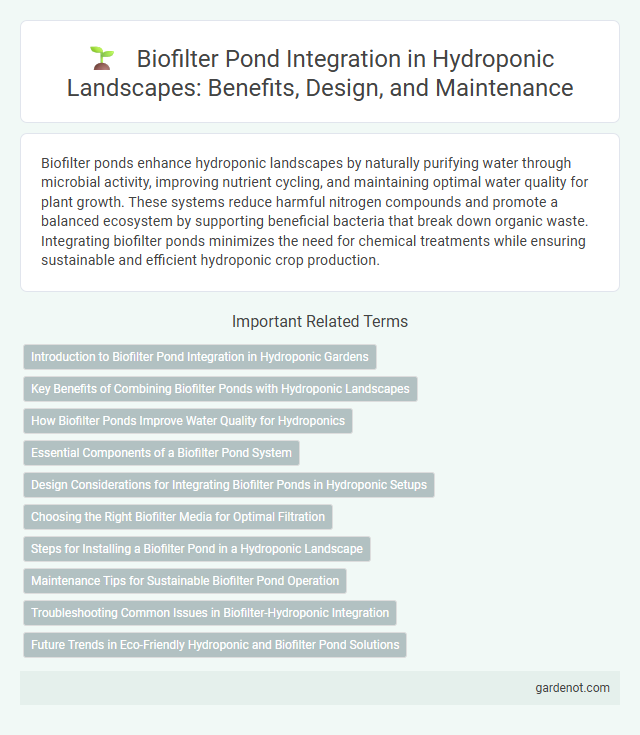Biofilter ponds enhance hydroponic landscapes by naturally purifying water through microbial activity, improving nutrient cycling, and maintaining optimal water quality for plant growth. These systems reduce harmful nitrogen compounds and promote a balanced ecosystem by supporting beneficial bacteria that break down organic waste. Integrating biofilter ponds minimizes the need for chemical treatments while ensuring sustainable and efficient hydroponic crop production.
Introduction to Biofilter Pond Integration in Hydroponic Gardens
Biofilter pond integration in hydroponic gardens enhances water quality by naturally removing harmful nutrients and toxins through beneficial microbial activity. This system supports plant health and growth by maintaining balanced nutrient cycles and reducing the need for chemical filtration. Efficient biofilter ponds optimize oxygen levels and promote sustainable water reuse within hydroponic landscapes.
Key Benefits of Combining Biofilter Ponds with Hydroponic Landscapes
Biofilter ponds enhance hydroponic landscapes by efficiently removing nutrients and harmful pathogens, improving water quality and promoting healthier plant growth. The natural filtration process supports sustainable water management, reducing the need for chemical treatments and minimizing environmental impact. Integrating biofilter ponds with hydroponic systems boosts productivity by creating a balanced ecosystem that recycles nutrients and maintains optimal growing conditions.
How Biofilter Ponds Improve Water Quality for Hydroponics
Biofilter ponds enhance water quality in hydroponic systems by leveraging natural microbial communities to break down organic waste and convert harmful nitrogenous compounds like ammonia into less toxic nitrate through nitrification. This biological filtration process reduces nutrient imbalances and prevents the accumulation of toxic substances, promoting healthier plant growth. Maintaining optimal oxygen levels and appropriate water circulation within biofilter ponds further supports efficient microbial activity, ensuring sustained water cleanliness and system stability in hydroponic landscapes.
Essential Components of a Biofilter Pond System
A biofilter pond system in hydroponic landscaping primarily consists of three essential components: the microbial biofilter media, the pond water, and aquatic plants. The biofilter media, often composed of porous materials like lava rock or ceramic rings, provides a large surface area for beneficial nitrifying bacteria to thrive, which convert harmful ammonia into nitrates. Aquatic plants not only absorb these nitrates as nutrients but also oxygenate the water, maintaining a balanced ecosystem vital for the system's overall health and water clarity.
Design Considerations for Integrating Biofilter Ponds in Hydroponic Setups
Biofilter ponds in hydroponic landscapes require optimized design to enhance nutrient cycling and water purification, incorporating appropriate surface area-to-volume ratios for effective microbial activity. Selecting substrates such as gravel or bio-balls maximizes biofilm development and oxygen transfer, while maintaining stable water flow rates prevents clogging and supports consistent filtration performance. Integrating native aquatic plants further promotes denitrification and reduces harmful pathogens, ensuring a balanced, sustainable hydroponic ecosystem.
Choosing the Right Biofilter Media for Optimal Filtration
Selecting the right biofilter media is crucial for effective filtration in hydroponic landscape biofilter ponds, as it impacts the surface area available for beneficial microbial colonization and nutrient breakdown. Media options like expanded clay pellets, lava rock, or specialized foam provide high porosity and durability, promoting optimal water quality by efficiently removing ammonia and nitrites. Ensuring media compatibility with the pond's biological load and flow rate enhances the stability of the aquatic ecosystem and supports healthy plant growth.
Steps for Installing a Biofilter Pond in a Hydroponic Landscape
Installing a biofilter pond in a hydroponic landscape involves selecting an appropriate location that ensures optimal sunlight and easy access for maintenance. Begin by excavating the pond area to the desired depth, followed by installing a waterproof liner to prevent water leakage. Incorporate biofilter media such as gravel, activated carbon, or bio balls to promote beneficial microbial growth, then connect water pumps and plumbing to facilitate continuous water circulation and filtration.
Maintenance Tips for Sustainable Biofilter Pond Operation
Regular removal of accumulated sludge and organic debris from the biofilter pond ensures optimal microbial activity and prevents clogging. Monitoring pH levels between 6.5 and 7.5 maintains a balanced environment for beneficial bacteria crucial for nutrient cycling. Periodic inspection of water flow rates and aeration systems guarantees efficient oxygen transfer, promoting sustainable biofilter performance in hydroponic landscapes.
Troubleshooting Common Issues in Biofilter-Hydroponic Integration
Biofilter ponds in hydroponic systems often face challenges such as clogging, uneven nutrient distribution, and fluctuating pH levels, which can disrupt plant growth and water quality. Regular maintenance including monitoring biofilter media for debris accumulation, adjusting water flow rates, and balancing microbial populations helps mitigate these issues. Employing real-time sensors for dissolved oxygen and ammonia concentrations enhances early detection and correction of biofilter malfunctions.
Future Trends in Eco-Friendly Hydroponic and Biofilter Pond Solutions
Biofilter ponds integrated with hydroponic systems are advancing as a core sustainable solution by enhancing water purification and nutrient recycling. Future trends emphasize smart biofilter technologies that optimize microbial activity to reduce contaminants, promoting healthier plant growth and ecosystem balance. Innovations include AI-driven monitoring systems and bioengineered filter media designed for maximal efficiency with minimal environmental impact.
Biofilter pond Infographic

 gardenot.com
gardenot.com